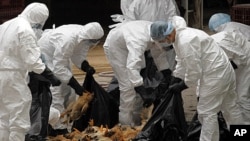A 39-year-old man is confirmed to have died of bird flu in recent days in the southern Chinese city, Shenzhen, after being admitted to hospital on Christmas Day. Authorities insist that the chances of further bird flu infections are minimal. Concern is mounting in neighboring Hong Kong.
The death of Shenzhen bus driver Chen Fayu this weekend represents the first bird flu fatality in China in 18 months.
Despite this being peak influenza season, Dr. Lo Wing-lok - an infectious diseases expert and former Hong Kong legislator - remains optimistic that the Shenzhen case may yet prove isolated. “Despite talks about mutation, the situation remains the same. The disease remains a bird-to bird disease; occasionally a bird-to-human disease," he explained. "But far from a human-to-human disease.”
However, Lo is skeptical of the Shenzhen authorities’ suggestion that avian flu is not prevalent among local poultry stocks, and that Chen likely contracted the H5N1 virus from wild birds. “This is a poultry virus, not a wild bird virus. Blaming human infection on wild birds is not conducive to epidemic control because people might become complacent about poultry, about slaughtering sick birds. As a result, more human cases could occur,” he said.
Residents of Hong Kong and the adjacent mainland Chinese province of Guangdong, in which Shenzhen is located, have reason to feel nervous about Chen’s death.
High density human populations live alongside animals kept for food. The conditions have helped make the region something of a cauldron for zoonosis - the transmission of animal diseases to human beings.
In 1996, Hong Kong recorded the cross-species transmission of avian flu, from birds to humans, resulting in multiple deaths. In 2003, the SARS (Severe Acute Respiratory Syndrome) epidemic had its genesis in Guangdong’s live-animal markets. Around 40 percent of the world’s total SARS fatalities occurred in Hong Kong, alone.
Shenzhen Disease Control Center confirmed Tuesday that Chen succumbed to a strain of the H5N1 virus intransmissible from human to human. Xinhua, the government news agency, urged the populace “not to panic”.
Officials are working to reassure and communicate openly with a nervous public.
"There’s a sea-change from the time of SARS when the Chinese government hid this disease that broke out in Guangdong at the end of 2002, and the outside world only heard about it after cases were seen in Hong Kong in February 2003," said Thomas Abraham, director of the Public Health Media Project at Hong Kong University. "There’s a huge change in terms of reporting."
In Hong Kong, authorities have taken steps to prevent the spread of avian flu, including a cull of 19,000 chickens in local markets and a ban on poultry imports from parts of Shenzhen.
However, the Hong Kong Center for Health Protection confirmed Tuesday that the virus strain which killed Chen is similar to the strain found in dead birds in Hong Kong last month.
Abraham wonders whether the media, both local and international, is exaggerating the extent of the bird flu threat following the latest death.
“H5N1 is endemic now. Whether they’re over-reacting or not, it depends which media you’re talking about. But if you’re asking me, ‘Is this [outbreak] unusual?’ I would say: ‘No. Because this has happened time and time again,’” Abraham stated.
Chinese Lunar New Year is just a few weeks away (January 23) and many more people are expected to come into contact with live poultry, and possibly the H5N1 virus, as chickens and ducks are slaughtered to celebrate one of China’s biggest annual holidays.








